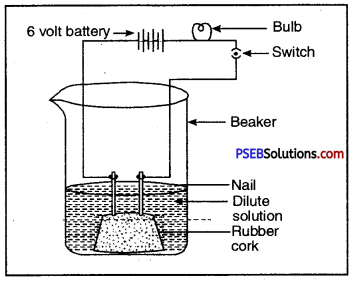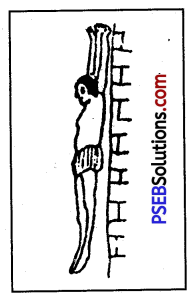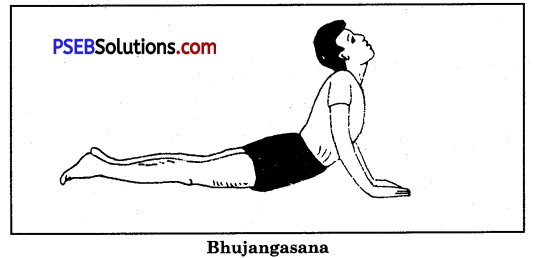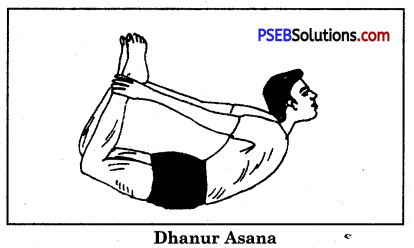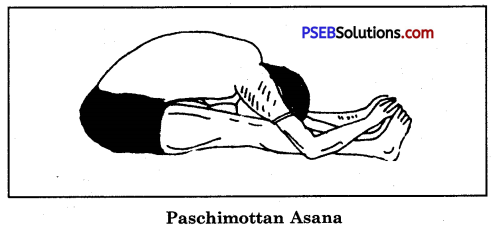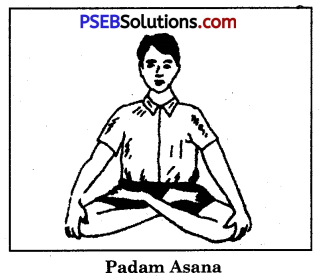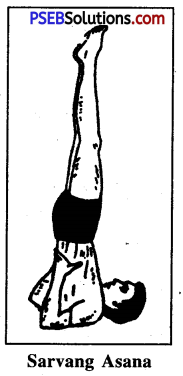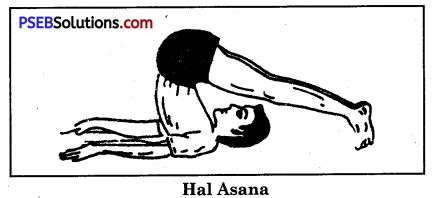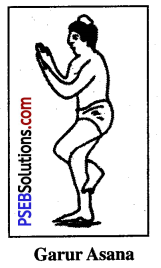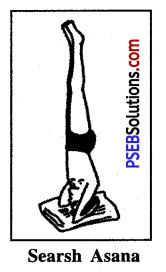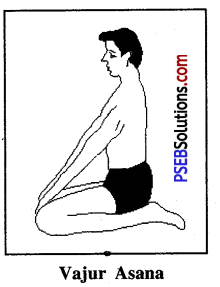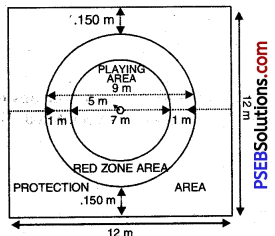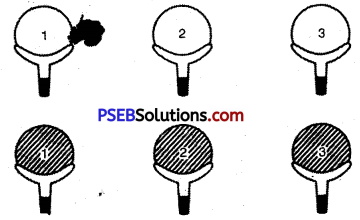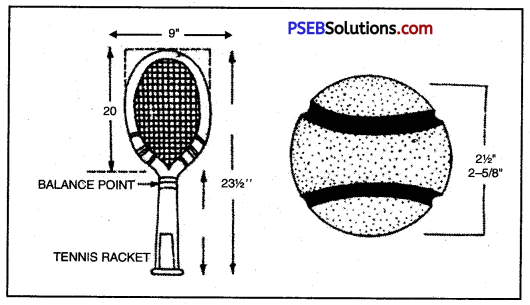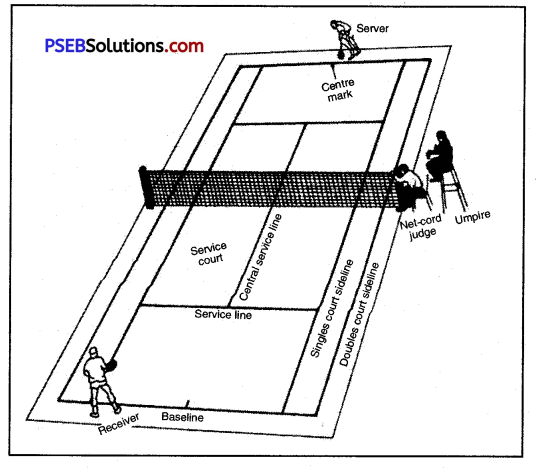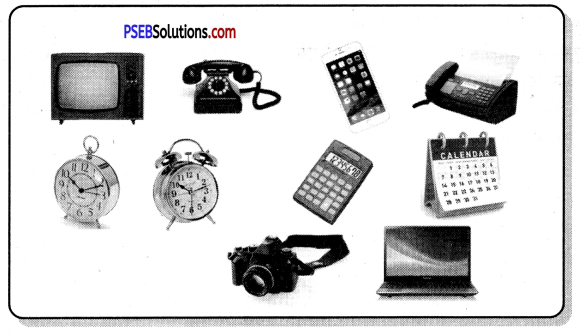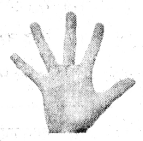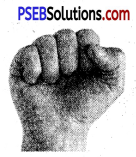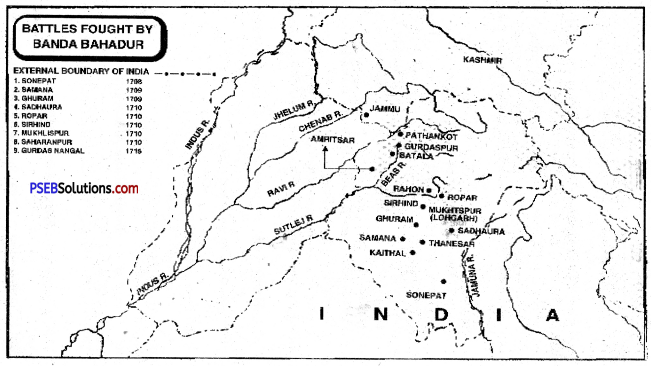Punjab State Board PSEB 10th Class English Book Solutions English Grammar Tenses Exercise Questions and Answers, Notes.
PSEB 10th Class English Grammar Tenses
Supply the correct form (Present Indefinite Tense) of the verbs in brackets.
1. Who (swim) in the pond every day?
2. We (burn) fuel to get heat.
3. Here (come) the bride.
4. The sun (rise) in the east.
5. They (come) to school by bus.
6. I (go) for a walk every day.
7. The Governor (arrive) tomorrow morning.
8. Raindrops (fall) from the clouds.
9. You always (speak) the truth.
10. I (be) the people, the mob, the crowd.
11. Father asked me, “How (be) you ?”
12. I (not object) to this proposal.
13. He (not like) mangoes.
14. When (leave) the train ?
15. The boys (know) the answer.
Answer:
1. swims
2. burn
3. comes
4. rises
5. come
6. go
7. arrives
8. fall
9. speak
10. am
11. are
12. do not object.
13. does not like
14. does (the train) leave
15. know.
![]()
Fill in the blanks with the Present Continuous form of the verbs given in brackets.
1. What ………………… you ………………… now ? (do)
2. They ……………… to London next week. (go)
3. Meera ………………… to see me tomorrow. (come)
4. We ………………… football. (play)
5. I ……………….. notes. (not take)
6. Why ……………. he ……………… at me ? (laugh)
7. Rajan ………………… a book. (write)
8. The boys ………………… in the river. (not swim)
9. The workers ……….. (paint)
10. Why ………………. he …………….. his clothes ? (change)
11. She ……………….. the candles. (blow out)
12. The old man …………….. with cold. (shiver)
Answer:
1. are (you) doing
2. are going
3. is coming
4. are playing
5. am not taking
6. is (he) laughing
7. is writing
8. are not swimming
9. are painting
10. is (he) changing
11. is blowing out
12. is shivering.
Rewrite the following sentences using the Present Perfect Tense of the verbs in brackets.
1. We (know) each other for the past ten years.
2. The appointed day (come).
3. Do you know what (happen) to his leg ?
4. I (finish) my work.
5. I (never deceive) you.
6. The train ……………….. just ……………….. . (arrive)
7. I shall go there after he (finish) his homework.
8. Why ………………. they …………….. there ? (go)
9. ………. She …………. her meals ? (have)
10. I (never see) the Taj.
Answer:
1. We have known each other for the past ten years.
2. The appointed day has come.
3. Do you know what has happened to his leg?
4. I have finished my work.
5. I have never deceived you.
6. The train has just arrived.
7. I. shall go there after he has finished his homework.
8. Why have they gone there ?
9. Has she had her meals ?
10. I have never seen the Taj.
Complete the following sentences, using the Present Perfect Continuous Tense of the verbs given in brackets.
1. We ………………. for you for two hours. (wait)
2. It ………………… since morning. (rain)
3. Who ……………… at the door for ten minutes ? (knock)
4. They ………………. here since 1997. (live)
5. The girls …………….. for two hours. (sing)
6. ……………….. he ………………… from fever since Monday ? (not suffer)
7. You ………………… this book since January. (write)
8. ………………… the tap ……………….. for two hours ? (not run)
9. Why ………………… you ………………. since yesterday ? (fight)
10. Why …….. to school for three days ? (not come)
Answer:
1. have been waiting
2. has been raining
3. has been knocking
4. have been living
5. have been singing
6. Has (he) not been suffering
7. have been writing
8. Has (the tap) not been running
9. have (you) been fighting
10. has (he) not been coming.
![]()
Fill in the blanks with the Past Indefinite form of the verbs given in brackets.
1. Meera ……………….. (turn) and ………………. (move) to the door.
2. We. ……………. (see) a lion in the jungle.
3. I ………………… (meet) him yesterday.
4. While the girls …………………… (sing), we ………(dance).
5. He…….. (go) out for ten minutes.
6. Who ………. (break) the window yesterday ?
7. She ………………. (send) him a letter last month.
8. They …………….. (know) the answer.
9. We ……….. (copy) from the blackboard.
10. The dog …….. (bite) the postman.
11. The birds ………………… (fly) away.
12. The little girl ………………. (cry) bitterly.
Answer:
1. turned, moved
2. saw
3. met
4. sang, danced
5. went
6. broke
7. sent
8. knew
9. copied
10. bit
11. flew
12. cried.
Rewrite the following sentences, using the Past Indefinite Tense of the verbs.
1. He counts the books.
2. The peon rings the bell.
3. We play cricket.
4. Mohan helps his father.
5. She reads a story.
6. Neetu drinks a glass of milk.
7. Suman shuts the window.
8. He rides a bicycle.
9. A thief steals some money.
10. The policeman holds up his hand.
Answer:
1. He counted the books.
2. The peon rang the bell.
3. We played cricket.
4. Mohan helped his father.
5. She read a story.
6. Neetu drank a glass of milk.
7. Suman shut the window.
8. He rode a bicycle.
9. A thief stole money.
10. The policeman held up his hand.
Fill in the blanks with the Past Continuous Tense of the verbs given in brackets.
1. I ………………. the truth. (speak)
2. A spider ….. over my body. (crawl)
3. When we arrived, they …………….. lunch. (have)
4. When I came, she ………………… (sing)
5. What . ….. when you arrived ? (do)
6. The plane ………………… violently. (shake)
7. My mother ………………. rice. (cook)
8. Why ………………. you ……….. (run)
9. What ………….. you ……. ……. last evening ? (do)
10. We …………….. a film when they came. (watch)
Answer:
1. was speaking
2. was crawling
3. were having
4. was singing
5. was (he) doing
6. was shaking
7. was cooking
8.were (you) running
9. were (you) doing
10. were watching.
![]()
Fill in the blanks with the suitable form (Past Perfect Tense) of the verbs given in brackets.
1. He ……………….. just ………….. his breakfast when I arrived. (finish)
2. The Nawab ……………. (die) years before his son took over.
3. The train ……………. (leave) before he reached the station.
4. The patient …………….. (die) before the doctor arrived.
5. The ship ………………. (sink) before help could reach.
6. He ………………… (completed his work when Meera came.
7. Why ……………… you ……………….. home till then ? (not reach)
8. I ……………(never expect) it to come this way.
9. ……… they …………. (buy) the tickets before the train arrived ?
10. Mother ………………. (tell) him not to go there.
11. Mahmood ………………… (be known) well throughout the city.
12. We ………………… often ………………… such messages. (receive)
Answer:
1. had (just) finished
2. had died
3. had left
4. had died
5. had sunk
6. had completed
7. had (you) not reached
8. had never expected
9. Had (they) bought
10. had told
11. had been known
12. had (often) received
Fill in the blanks with the Past Perfect Continuous Tense of the verbs given in brackets.
1. We …….. (wait) for you for ten hours when you came.
2. He said that he ………………… (live) here for ten years before they met him.
3. She told me that she ………………… (work) for four hours before the light went off.
4. Seema ………………. (suffer) from fever for a month before her examinations started.
5. She ………………. (knit) a sweater for a month before she fell ill.
6. It …………….. (rain) for two days.
7. The farmer ………………. (milk) the cow for an hour before the bell rang.
8. She ……………….. (teach) us English since 2001.
9. The police ……………… (look for) this thief for the last five years.
10. The boys ………………… (learn) their lessons for two hours before the test started.
Answer:
1. had been waiting
2. had been living
3. had been working
4. had been suffering
5. had been knitting
6. had been raining
7. had been milking
8. had been teaching
9. had been looking for
10. had been learning.
Rewrite the following sentences, changing the verb in each sentence into the Future Indefinite Tense.
1. Malcom closed his eyes.
2. I am going home.
3. The boys have been playing cricket.
4. She has finished her homework.
5. I had written a letter.
6. They paint pictures.
7. We are locking the door.
8. Madan is listening to the radio.
9. The teacher teaches us a new lesson.
10. Kalpana has been dancing and singing.
11. Did you go there?
12. Why did you break the windowpane?
Answer:
1. Malcom will close his eyes.
2. I will go home.
3. The boys will play cricket.
4. She will finish her homework.
5. I shall write a letter.
6. They will paint pictures.
7. We shall lock the door.
8. Madan will listen to the radio.
9. The teacher will teach us a new lesson.
10. Kalpana will dance and sing.
11. Will you go there ?
12. Why will you break the windowpane ?
Rewrite the following sentences after changing the Tense into the Future Continuous.
1. I boarded a plane.
2. She was playing on the harmonium.
3. The peon rings the bell.
4. Hari bought this watch from this shop.
5. They are reading newspapers.
6. We have been playing football.
7. Mamta has cooked the dinner.
8. She sang a beautiful song.
9. The children have eaten a chocolate ice cream.
10. He had been collecting stamps.
Answer:
1. I shall be boarding a plane.
2. She will be playing on the harmonium,
3. The peon will be ringing the bell.
4. Hari will be buying this watch from this shop.
5. They will be reading newspapers.
6. We shall be playing football.
7. Mamta will be cooking the dinner.
8. She will be singing a beautiful song.
9. The children will be eating a chocolate ice cream.
10. He will be collecting stamps.
![]()
Fill in the blanks with the Future Perfect Continuous Tense of the verbs.
1. It ………………. (snow) in Shimla since morning.
2. What ………………… you ………………… ? (write)
3. We ……………….. (play) for three hours when you come here.
4. Anand ……………… (live) in Jaipur for ten years.
5. She ……………… (read) this book for ten days.
6. I ………………… (live) in Chennai for two months.
7. ……………… the tap …………….. (run) for an hour before you turn it off ?
8. The mechanic ………………… (repair) my car for an hour.
9. He ……. (suffer) from fever for six days before you get him admitted to the hospital.
10. Sita ……………….. (knit) my sweater for a month before she leaves for Mumbai.
Answer:
1. will have been snowing
2. will (you) have been writing
3. shall have been playing
4. will have been living
5. will have been reading
6. will have been living
7. Will (the tap) have been running
8. will have been repairing
9. will have been suffering
10. will have been knitting.
Correct the following sentences.
1. She had left yesterday.
2. I had gone to Chennai last week.
3. She is reading the ‘Gitanjali’ for the last six days.
4. She finished her work when I met her.
5. When I finished my dinner, I shall read a book.
6. The train left the station before I reached there.
7. I lived in Chandigarh since 1978.
8. Edison has invented the gramophone.
9. She had been born in 1980.
10. They are working hard since last month.
Answer:
1. She left yesterday.
2. I went to Chennai last week.
3. She has been reading the “Gitanjali’ for the last six days.
4. She had finished her work when I met her.
5. When I have finished my dinner, I shall read a book.
6. The train had left the station before I reached there.
7. I had been living in Chandigarh since 1978.
8. Edison invented the gramophone.
9. She was born in 1980.
10. They have been working hard since last month.
Tense (काल)-Verb के जिस रूप से यह पता चले कि क्रिया कब हुई है, उसे Tense कहा जाता है।
Tense तीन प्रकार के होते हैं
(A) Present Tense (वर्तमान काल)
(B) Past Tense (भूतकाल)
(C) Future Tense (भविष्य काल)
(A) present tense
1. Present Indefinite Tense
प्रयोग – इस Tense का प्रयोग निम्नलिखित स्थितियों में किया जाता है-…
1. सदा-सत्य बातों के लिए –
(The sun shines by day, and the moon by night.)
2. चरित्र-सम्बन्धी स्थायी आदतों के लिए –
(He never tells a lie.)
3. वास्तविक वर्तमान और निकट भविष्य के लिए –
1. I understand what you say
2. He leaves for Mumbai tomorrow.
नियम — (1) इस Tense में Verb की पहली फार्म का प्रयोग किया जाता है।
(2) यदि subject एकवचन हो, तो verb की पहली फार्म के साथ s या es का प्रयोग किया जाता है।
(3) Negative तथा Interrogative वाक्यों में Helping Verb के रूप में do/does का प्रयोग किया जाता है।
(4) बहुवचन subject के लिए do का, तथा एकवचन subject के लिए does का प्रयोग किया जाता है। Does के साथ प्रयोग की जाने वाली Verb की पहली फार्म के साथ 8 या es नहीं लगाया
जाता है।
(5) I तथा you के लिए प्रयोग की जाने वाली Verb की पहली फार्म के साथ s या es नहीं लगा जाता है। इनके लिए बहुवचन subject की भान्ति केवल Verb की पहली फार्म का’ प्रयोग किया जाता है।
2. Present continuous Tense
प्रयोग – इस Tense का प्रयोग निम्नलिखित स्थितियों में किया जाता है.
1. बोलने या लिखने के समय चल रही किसी घटना का वर्णन करने के लिए; जैसे
(He is writing a letter.)
2. किसी आदत अथवा व्यवहार का वर्णन करने के लिए भी कभी-कभी इस Tense का प्रयोग किया जाता है; जैसे
(She is working regularly these days.)
नियम – इस Tense के वाक्यों में is / am / are लगा कर Verb के ing वाले रूप का प्रयोग किया जाता है।
Subject + is / am / are + Verb का ing वाला रूप + …………..
Note : Present Continuous Tense तथा Present Indefinite Tense के अन्तर को अच्छी
प्रकार समझ लेना चाहिए। निम्नलिखित नियम याद रखिए
Present Indefinite Tense – for habitual actions; for universal truths; for actions going to take place in near future.
Present Continuous Tense – for actions in progress at the time of speaking.
3. Present Perfect Tense
प्रयोग – इस Tense का प्रयोग अभी-अभी (वर्तमान में) पूरी हुई किसी घटना का वर्णन करने के लिए किया जाता है। नियम – इस Tense के वाक्यों में has / have लगा कर Verb की तीसरी फार्म का प्रयोग किया जाता है; जैसे
1. She has just finished her work.
2. I have spent all my money on books.
![]()
4. Present Perfect Continuous Tense
प्रयोग – इस Tense का प्रयोग तब किया जाता है जब कोई क्रिया भूतकाल में आरम्भ हुई हो और अब भी ।
चल रही हो; जैसे
1. He has been reading English for two years.
2. They have been reading this book since morning.
नियम –
(1) इस Tense के वाक्यों में has / have + been + V1-ing + since / for at sem किया जाता है।
(2) For का प्रयोग तब किया जाता है जब क्रिया के जारी रहने की अवधि (period of time) दी हुई हो; जैसेfor fifteen minutes; for half an hour; for a month; for three years; for a long time.
(3) Since का प्रयोग तब किया जाता है जब क्रिया के आरम्भ होने का निश्चित समय (point of time) दिया हुआ हो; जैसे since Sunday; since breakfast; since yesterday; since Diwali; since January 1998; since the first of May.
Past Tense
1. Past Indefinite Tense
प्रयोग – इस Tense का प्रयोग तब किया जाता है जब कोई घटना भूतकाल में आरम्भ होकर भूतकाल में ही समाप्त हो गई हो।
(We learnt English at school.)
नियम –
(1) इस Tense के affirmative वाक्यों में Verb की दूसरी फार्म का प्रयोग किया जाता है।
(2) Negative वाक्यों में did not + Verb की पहली फार्म का प्रयोग किया जाता है।
(3) Interrogative वाक्यों में Did + subject + Verb की पहली फार्म का प्रयोग किया जाता है।
(4) Did का प्रयोग करने के बाद सदा Verb की पहली फार्म का ही प्रयोग किया जाता है।
2. Past continuous Tense
प्रयोग – इस Tense का प्रयोग तब किया जाता है जब कोई क्रिया भूतकाल में किसी निश्चित समय पर चल रही हो।
(He was writing a letter when I saw him.)
नियम – इस Tense के वाक्यों में was / were लगा कर Verb के ing वाले रूप का प्रयोग किया जाता है।
Note : Past Continuous Tense तथा Past Indefinite Tense के अन्तर को अच्छी प्रकार से समझ लेना चाहिए। निम्नलिखित नियम याद रखिए
Past Indefinite Tense for completed activity.
Past Continuous Tense – for. continuity in past.
3. Past Perfect Tense
प्रयोग – इस Tense का प्रयोग तब किया जाता है यदि कोई क्रिया भूतकाल में किसी निश्चित समय (moment) से पहले या किसी निश्चित समय तक पूरी हो चुकी हो।
1. The patient had died before the doctor came.
2. I had finished my work by evening.
नियम – इस Tense में had लगा कर Verb की तीसरी फार्म का प्रयोग किया जाता है।
Note : यदि किसी वाक्य में भूतकाल में घटी हुई दो घटनाओं का वर्णन हो, तो उनमें से जो घटना पहले घटी हो, उसके लिए Past Perfect Tense का प्रयोग किया जाता है, और जो घटन अपेक्षाकृत बाद में घटी हो, उसके लिए Past Indefinite Tense का प्रयोग किया जाता
4. Past Perfect continuous Tense
प्रयोग – इस Tense का प्रयोग तब किया जाता है यदि कोई क्रिया भूतकाल में आरम्भ होकर भूत ही किसी निश्चित समय पर चल रही हो; जैसे
(When I reached there at 2 p.m.he had been waiting for 1:30 p.m.).
नियम- इस Tense के वाक्यों में had + been + V1-ing + since / for का प्रयोग कि
Future Tense
1. Future Indefinite Tense प्रयोग -इस Tense का प्रयोग साधारण रूप में भविष्य में होने वाली किसी घटना का वर्णन करने के लिए किया जाता है; जैसे
(The post will arrive late. We shall start early.)
नियम- इस Tense के वाक्यों में will / shall लगा कर Verb की पहली फार्म का प्रयोग किया जाता है।
Note : Will और Shall सम्बन्धी प्रयोग के लिए निम्नलिखित नियम ध्यान में रखिए
Assertive alert
1. यदि किसी भविष्य की घटना का केवल साधारण रूप से ही वर्णन हो, तो First Person के लिए shall का प्रयोग किया जाता है। Second और Third Persons के लिए will का प्रयोग किया जाता है।
2. यदि वाक्य में किसी भविष्य-सम्बन्धी आदेश (command), प्रण (promise), निश्चय (determination), धमकी (threat), आदि का वर्णन हो, तो First Person के लिए will का प्रयोग किया जाता है।
3. यदि वक्ता अपने किसी भविष्य-सम्बन्धी उद्देश्य (intention) को प्रकट करना चाहता हो तो वह अपने लिए will का प्रयोग करेगा। अर्थात् ऐसे वाक्यों में First Person के साथ will का प्रयोग किया जाता है।
Interrogative वाक्यों में
1. प्रश्नवाचक वाक्यों में प्रायः Will I और Shall you का प्रयोग नहीं किया जाता है।
2. Third Person के लिए will अथवा shall, किसी का भी प्रयोग किया जा सकता है।
Shall he – भविष्य-सम्बन्धी आदेश, आदि के लिए।
Will he – भविष्य-सम्बन्धी साधारण क्रिया के लिए।
2. Future Continuous Tense
प्रयोग- इस Tense का प्रयोग तब किया जाता है जब भविष्य में किसी विशेष समय का वर्णन हो, और कोई क्रिया उस विशेष समय से पहले आरम्भ होकर उसके बाद में पूरी होनी हो; जैसे (We shall be waiting for you when you get back tomorrow.)
नियम- इस Tense के वाक्यों में will / shall के साथ be लगा कर Verb के ing वाले रूप का प्रयोग किया जाता है।
Note: Future Continuous Tense तथा Future Indefinite Tense के अन्तर को अच्छी तरह से समझ लेना चाहिए।
निम्नलिखित नियम याद रखिए
Future Indefinite Tense – for an action which begins at a certain future moment.
Future Continuous Tense – for an action which begins before and finishes after a certain future moment.
![]()
3. Future Perfect Tense प्रयोग – इस Tense का प्रयोग तब किया जाता है जब कोई क्रिया भविष्य में किसी समय से पहले पूरी होनी हो; जैसे
(I will have finished my homework by evening.)
नियम- इस Tense में will / shall + have लगा कर Verb की तीसरी फार्म का प्रयोग किया जाता है।
4. Future Perfect Continuous Tense प्रयोग-इस Tense का प्रयोग तब किया जाता है यदि क्रिया भविष्य में किसी निश्चित समय
(point of time) तक अथवा किसी निश्चित अवधि (period of time) के लिए जारी रहनी हो; जैसे
(By six o’clock, I will have been sitting here for ten hours.)
नियम- इस Tense में will / shall + have been लगा कर Verb के ing वाले रूप का प्रयोग किया जाता है।
| Indefinite | Continuous | Perfect | Perfect Continuous | |
| PRESENT PAST FUTURE |
write (s) wrote will/shall write |
is/am/are writing was/were writing will/shall be writing | has/have written had written will/shall have written |
has/have been writing had been writing will/shall have been writing |
I. Fill In the blanks with the Present Indefinite form oF the verbs given in the brackets.
1. He ……….. for a walk every day. (go)
2. She ……….. up early in the morning. (get)
3. The peon ……… the bell at 9 o’clock. (ring)
4. I ……….. my parents. (obey)
5. We ……….. our teachers. (respect)
6. We ……….. our prayers in the morning. (set)
7. She ……….. sweetly. (sing)
8. I do not ……….. sweets. (like)
Answer:
1. goes
2. gets
3. rings
4. obey
5. respect
6. say
7. sings
8. like
II. Fill in the blanks with the Present Continuous form of the verbs given in the brackets.
1. ………. it ……….. today? (rain)
2. …….. the peon ……….. the bell? (ring)
3. ………. the boys ……….. football? (play)
4. He ………. a picture. (paint)
5. We ………. our lesson. (learn)
6. She ……….. not ……….. food. (cook)
7. I……….. a letter. (write)
8. You ……….. a race. (run)
Answer:
1. Is, raining
2. Is, ringing
3. Are, playing
4. is painting
5. are learning
6. is, cooking
7. am writing
8. are running.
III. Fill in the blanks with the Present Perfect form of the verbs given in the brackets.
1. I …… my homework. (finish).
2. He ………………….. first in the class. (stand)
3. ………………………. you ……………. your scooter? (sell)
4. ……… she ……………. a car? (buy)
5. They ……….. their enemy. (defeat)
6. We …………….. the match. (win)
7. The peon ………………….. the bell. (ring)
8. We …………………… our duty. (do)
Answer:
1. have finished
2. has stood
3. Have, sold
4. Has, bought
5. have defeated
6. have won
7. has rung
8. have done.
IV. Fill in the blanks with the Present Perfect Continuous form of the verbs given in the brackets.
1. ……………… since morning. (rain)
2. She ………………. from fever for a week. (suffer)
3. I ………………… for you for half an hour. (wait)
4. He ………………… his brother with money for five years. (help)
5. We ……. for a long time. (fight)
6. She ………………… for a job for several months. (look)
7. …………………… he ……………………. books from you since 1991 ? (borrow)
8. ……… she…… in this office since 1987 ? (work)
Answer:
1. has been raining
2. has been suffering
3. have been waiting
4. has been helping
5. have been fighting
6. has been looking
7. Has been borrowing
8. Has been working
V. Fill in the blanks with the Past Indefinite form of the verbs given in the brackets.
1. India ……………….. independence in 1947. (get)
2. He ……………………. government service in 1980 (join)
3. It ………………….. heavily last night. (rain)
4. ……………….. he …………………. you money ? (lend)
5. She ……………….. not ………………… to my proposal. (agree)
6. Why …………………. he …………………… angry with you ? (become)
7. The teacher …………………. the student. (punish)
8. He …………………. to go for a walk daily. (use)
Answer:
1. got
2. joined
3. rained
4. Did, lend
5. did, agree
6. did, become
7. punished
8. used.
VI. Fill in the blanks with the Past Continuous form of the verbs given in the brackets.
1. It …………….. in the morning. (rain)
2. The peon …………………. the bell. (ring)
3. Why ……………. she (weep)
4. She ……………….. clothes. (wash).
5. …………………… she …………………… food ? (eat)
6. …………. the hunter …………………….. birds ? (kill)
7. It …………………… Since
6. She ……….. not food …………… (cook)
7. I ………………….. a letter. (write)
8. You ……………………. a race. (run)
7. He ………………….. a novel. (read)
8. My grandmother ………. a story. (tell)
Answer:
1. was raining
2. was ringing
3. was, weeping
4. was washing
5. Was, eating
6. Was, killing
7. was reading
8. was telling.
![]()
VII. Fill in the blanks with the Past Perfect form of the verbs given in the brackets.
1. He ……… a tiger before I reached the forest. (kill)
2. She …………………. a sweater before I bought a new one. (knit)
3. I …………….. money from my friend before I received my salary. (borrow)
4. The river …………………… its banks before the dam was built. (overflow)
5. …………………… she ………………….. a new dress before his father came ? (buy)
6. Why …………….. he ……………. ……. you before everybody ? (abuse)
7. My uncle ……………… a new house before he retired from service. (build)
8. …….. you in the race before you defeated him in boxing ? (beat)
Answer:
1. had killed
2. had knitted
3. had borrowed
4. had overflowed
5. Had,bought
6. had, abused
7. had built
8. Had, beaten.
VIII. Fill in the blanks with the Past Perfect Continuous form of the verbs given in the brackets.
1. We ………. in Delhi for ten years. (live)
2. He ……… in this office since 1990. (work)
3. She …………………. in this school for ten years. (teach)
4. ……………………. you ……………………. your brother for five years ? (look after)
5. Who ………………….. you with money all these years? (help)
6. The farmer …………………. the fields for many days. (plough)
7. The teacher …………………… the students for a long time. (guide)
8. They …………………… their country for thirty years. (serve).
Answer:
1. had been living
2. had been working
3. had been teaching
4. Had, been
looking after
5. had been helping
6. had been ploughing
8. had been guiding
8. had been serving.
IX. Fill in the blanks with the Future Indefinite form of the verbs given in the brackets.
1. I ……………….. to Delhi.(go)
2. We …….. you with money. (help)
3. The peon ……………….. the bell at 9 o’clock. (ring)
4. …………. she ………………….. in time ? (crime)
5. …………………… he …………………… you his book ? Glend)
6. She ……………………. a rich man. (marry)
7. The train …………………… in time. (arrive)
8. They …………………… a match tomorrow. (play)
Answer:
1. shall go
2. shall help
3. will ring
4. Will, come
5. Wil, lend
6. will marry
7. will arrive
8. will play
X. Fill in the blanks with the Future Continuous form of the verbs given in the brackets.
1. She ………………….. a picture. (paint)
2. I ……. a new car. (buy)
3. He ………………….. to Delhi tomorrow.(go)
4. They …………………… their friends. (help)
5. People ……………………. their work. (do)
6. ……………………. she ………………….. food ? (cook)
7. ….. in the river ? (bathe)
8. He …………………. not …………. his friends. (cheat)
Answer:
1. will be painting
2. shall be buying
3. will be going
4. will be helping
5. will be doing
6. Will, be cooking
7. Will, be bathing
8. will, be cheating
XI. Fill in the blanks with the Future Perfect form of the verbs given in the brackets.
1. She ……….. her work in time. (finish)
2. He ……………………. you with money. (help)
3. They …………………. their clothes. (wash)
4. I. ……………… the situation. (handle)
5. She ……………….. her promise. (break)
6. He ……………………. you money. (lend)
7. she ………. you English? (teach)
8. ………… bravely? (fight)
Answer:
1. will have finished
2. will have helped
3. will have washed
4. shall have handled
5. will have broken
6. will have lent
7. Will, have taught
8. Will, have fought.
![]()
XII. Fill in the blanks with the Future Perfect Continuous form of the verbs given in the brackets.
1. It …………….. for two hours. (rain)
2. They ……………………. here for many years. (live)
3. She …………………. English since 1980. (learn)
4. He ………………… Mathematics for many years. (teach)
5. …………………. she ……………………. in this office since 1985 ? (work)
6. He ………………….. you for a long time. (cheat)
7. They ………………….. the poor since 1982. (help)
8. ……………. she ……………… food for the whole family for several years? (cook)
Answer:
1. will have been raining
2. will have been living
3. will have been learning
4. will have been teaching
5. Will, have been working
6. will have been cheating
7. will have been helping
8. Will, have been cooking.



